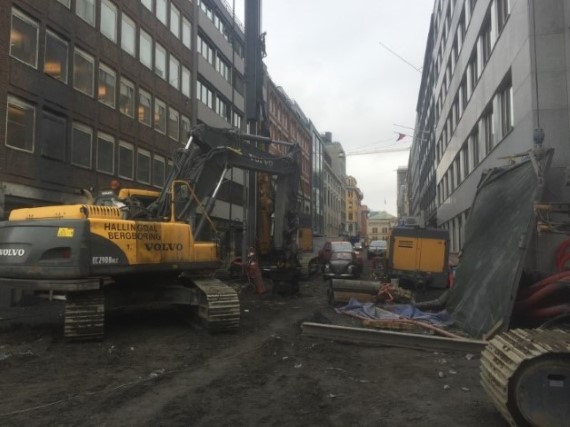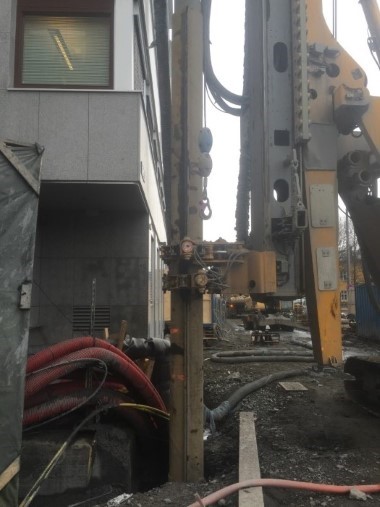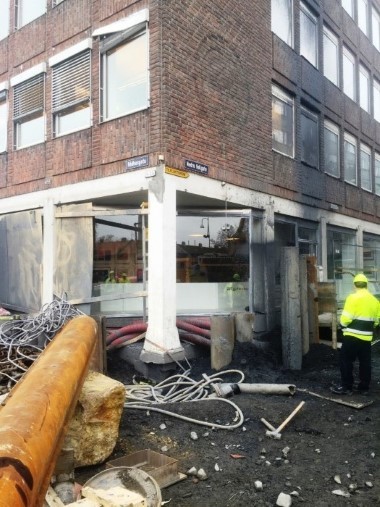RD pile wall for tunnel to Stortinget building in Norway
Underneath the street Nedre Vollgate, a 250 m long supply tunnel for a new post and goods reception for Stortinget (the Parliament) is to be build. The challenges when building a tunnel below an existing street in Oslo are many. The area is cramped with little room to work, tight access and difficulties to store materials and equipment. Drilling of RD pile wall is restricted to nights (after office hours) because of business running as usual in adjacent buildings.

Figure 1. Nedre Vollgate; the street where the RD pile walls are installed on both sides, prior to excavation and making the tunnel. Stortinget (the Parliament) is located at the end of the street.
A solution was needed for establishing retaining walls through varying soil conditions and securely into bedrock, very close to existing buildings. By using RD pile walls this is possible and at the same time keep the buildings in low risk of damage. Later the street can be excavated, the supply tunnel can be build and the street can be reestablished on top of the tunnel.
Figure 2. Drilling is done only appr. 0.5 m away from the building. Conditions are challenging with all the cables and installations in the ground.
The designer Multiconsult AS found RD400/10 (steel grade S355J2H) with RM/RF-interlocks to be the best solution for this task, drilled 2 m into bedrock, and with interlocks sealed with Pertex. The total number of piles is currently predicted to be 436, and the lengths vary from 9 to 14 m. The total amount is very close to exactly 5 000 m or 560 tons. The drilling started earlier this year and will continue yet some time.
The work is time consuming due to restrictions in work hours and many of the installations in the ground. There has been activity here in more than 100 years, so it is obvious that not everything is mapped and surveyed like we do now, see figure 2. The deliveries to the site have been challenging because there is lack of space.
Normally SSAB delivers piles directly from own works in Finland to the construction site. For this project we had to find a solution for customer to store piles temporarily at a different site before installation. Arrangements were done in cooperation with Tibnor. That way we are able to deliver exactly on time also when progress changes due to unexpected events.
Figure 3. Challenging conditions with known and unknown cables in the ground and the adjacent buildings that require extra precaution.
RD Pile wall – Retaining wall structures based on steel piles
Based on RD piles (RD220–RD1200) and installed by drilling, RD pile walls are suitable for retaining wall structures in demanding ground conditions. RD piles are connected by welded interlocking sections, creating a continuous pipe pile wall against horizontal and vertical loads. The RD pile wall is installed with an oversize ring bit instead of a normal ring bit. The RD pile wall is always installed by percussion drilling methods, using a DTH hammer. The drilling method is centric.
Pile pipes used in RD pile walls are SSAB’s drilled RD220-RD1200 piles. RD piles are special piles, installed by drilling in difficult ground and environmental conditions. RD piles are based on longitudinally or spiral welded steel pipes. The generally used steel grade of RD piles is S440J2H, but grades S355J2H and S550J2H as well as X60 and X70 are also used. Pile pipes for the RD wall are spliced by welding.
In the RD pile wall the pipe piles are attached to each other by interlocking sections. Adjacent piles are always interlocked using a pair of interlocking sections, a narrow and a wide one. Two different interlock types developed for the RD pile wall are available: the SSAB RM/RF interlock and the SSAB E21 interlock. SSAB’s new RM/RF interlock and the injection channel integrated in it ensure the water tightness of the toe of the RD pile wall and its rigid contact with rock without separate injection pipes.
Figure 4. SSAB RM/RF interlock and integrated injection channel ensure water tightness of the toe of the RD pile wall.
Załączniki
Kategorie i tagi


